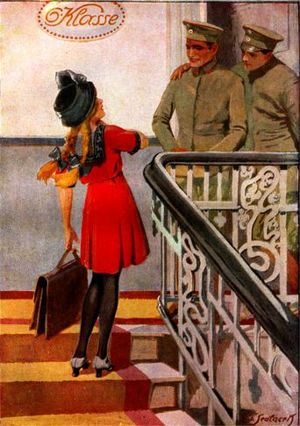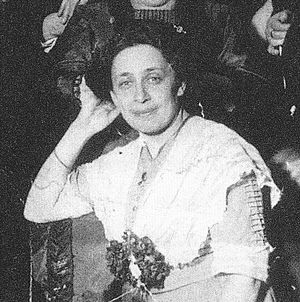Else Ury facts for kids
Quick facts for kids
Else Ury
|
|
|---|---|
 |
|
| Born | 1 November 1877 |
| Died | 13 January 1943 (age 65) Auschwitz-Birkenau, German-occupied Poland
|
| Cause of death | Gas poisoning |
| Nationality | German |
| Occupation | Novelist |
| Known for | Nesthäkchen Series and other books for girls |
Else Ury (born 1 November 1877 – 13 January 1943) was a famous German-Jewish writer. She wrote many popular books for children. Her most famous character is Annemarie Braun, a doctor's daughter. Annemarie's life, from childhood to old age, is told in the ten Nesthäkchen books.
These books were so successful that they became a six-part TV series in 1983. Millions of people have read her books and watched the TV show. Else Ury was a member of the German middle class. She loved her country but also kept her Jewish heritage. This mix of feelings can be seen in her writing. However, the Nesthäkchen books do not mention Judaism. In 1943, Else Ury was sent to the Auschwitz concentration camp. She was killed there when she arrived.
Contents
Else Ury's Early Life and Family
Else Ury was born in Berlin, Germany, on November 1, 1877. She grew up in a Jewish family of merchants. Her happy childhood and time with her large family gave her ideas for her books. Her family lived in a wealthy home with many servants. This kind of home is often described in her Nesthäkchen series.
Else's father, Emil Ury, became a very successful merchant. Her mother, Franziska Ury, loved classic and modern books, art, and music. She shared these interests with her children.
Else's brothers and sister also had successful careers. Ludwig became a lawyer, and Hans became a doctor. Her sister Käthe planned to be a teacher before getting married. Else, however, chose to become a writer.
How Else Ury Became a Writer
Else Ury went to the Lyzeum Königliche Luisenschule. But she decided not to pursue a regular job. Instead, she started writing under a pen name for a newspaper called the Vossische Zeitung.
In 1905, her first book was published. It was called Was das Sonntagskind Erlauscht (What the Lucky Child Heard). This book was a collection of 38 short stories. They taught important lessons like loyalty, honesty, and faithfulness.
Her next book, Goldblondchen (1908), was also very well-received. Else Ury wrote five more successful books after that. Then, between 1918 and 1925, the Nesthäkchen series came out. These books made her a very famous author.

Else Ury wrote over 39 books. This made her one of the most productive writers of her time. She was also one of the most successful. Her books were best-sellers because they were smart, funny, and kind. She was very celebrated for her work.
On her 50th birthday in 1927, her publisher held a big party for her. It was at the famous Hotel Adlon in Berlin.

Else Ury became rich from her writing. She even bought a vacation home in Krümmhubel (Karpacz). She called her home "Haus Nesthäkchen" (Nesthäkchen House). By 1933, she had earned a huge amount of money from her books. Millions of fans bought her books. They also listened to her stories on the radio and read her newspaper articles. Else Ury was like a superstar in Germany at that time.
Else Ury Tries to Leave Germany
By 1939, life for Else Ury in Germany had become very difficult. She was Jewish, and the situation under the Nazi government was getting worse. She tried to sell her books in England and the United States. She hoped this would help her earn money to move out of Germany.
She sent her stories to relatives in London. One of her nephews tried to help her find someone to translate her books into English. She also had contact with another nephew, Fritz, who knew a literary agent. This agent, Karl Ludwig Schröder, was in touch with a Hollywood agent named Paul Kohner. Hollywood was looking for stories for child stars.
Else Ury and the agents tried to get her books noticed in Hollywood. They thought her books would be great for child stars like Shirley Temple. They even compared her books to the famous story of Heidi.
However, World War II started on September 1, 1939. This ended all of Else Ury's hopes and contacts. She could no longer try to leave Germany.
Deportation and Death
As a Jewish person during The Holocaust, Else Ury faced terrible persecution. She was no longer allowed to publish her books. Her belongings were taken away from her.
On January 13, 1943, Else Ury was sent from Berlin to the Auschwitz concentration camp. She was murdered there on the very day she arrived. Out of 1,000 people on her transport, 873 were immediately killed. They were not even registered at the camp.
Books and TV After the War
After World War II, Else Ury's books were published again. A new version of the Nesthäkchen series came out in 1952. The first book was called "Nesthäkchen and her Dolls."
One important change was made: The fourth book, "Nesthäkchen and the World War," was not reprinted. This book was about World War I. A short chapter was added to the third book to explain what happened in the fourth book. This helped the story continue smoothly.
The other nine Nesthäkchen books have been printed many times. More than seven million copies have been sold in total. In 1983, the German TV channel ZDF made a Christmas show based on the first Nesthäkchen books. These TV shows were released on DVD in 2005.
Memorials to Else Ury
In 1994, a book about Else Ury was published. It was called Nesthäkchen arrives in the Concentration Camp. This book helped many people learn about her murder at Auschwitz.
Today, there are memorials to Else Ury in Berlin and Karpacz. Karpacz is where her vacation home was located. Her old vacation home is now in Poland and is called "Dom Nesthäkchen" (the Nesthäkchen House).
Her last home in Berlin was torn down after the war. But a special memorial stone was placed there. It reminds people of Else Ury and others who died in the Holocaust. An S-Bahn (train) arch in Berlin is also named in her honor. There is also a memorial at the Jewish Cemetery in Berlin.
Nesthäkchen and the World War
In her book Nesthäkchen and the World War, Else Ury tells the story of Annemarie Braun. Annemarie is 11 years old when the story begins and 13 when it ends. Annemarie's father is a doctor in the army in France. Her mother is in England and cannot return to Germany because of the war. Annemarie and her two older brothers live with their grandmother.
A big part of the story is about Annemarie's experiences with a new classmate, Vera. Vera is German-Polish and does not speak German at first. Annemarie is popular but unkind to Vera. She treats Vera like an outsider and a spy. This makes Vera a lonely person in the class. The way this problem is solved is very exciting and has kept readers interested for a long time.
The war happening in the background also makes Nesthäkchen and the World War a powerful story. It shows the harsh nature of war.
After 1945, this book was removed from the Nesthäkchen series. The Allied forces who controlled Germany after the war thought the book made Germany's war efforts seem too good. Since 1945, the Nesthäkchen series has only nine books.
The book Nesthäkchen and the World War was translated into English in 2006. Another book, Nesthäkchen in the Children's Sanitorium, was translated in 2014. Else Ury wrote many other books and stories, mostly for girls and young women. Most of her books are still available today.
Else Ury's Books
The Nesthäkchen Series
The Nesthäkchen series is a type of German book called a Backfischroman. These were novels for girls, usually aged 12 to 16. They told stories about growing up. A "Backfisch" was a teenage girl. These books were popular between 1850 and 1950. They often showed girls learning traditional social rules. The stories usually ended with the main character getting married and becoming a housewife.
Other famous authors of Backfischroman books included Magda Trott and Emmy von Rhoden. Else Ury originally planned to end the Nesthäkchen series with the sixth book. But her publisher received many letters from young fans. They begged for more Nesthäkchen stories. So, Else Ury wrote four more books. She even mentioned her doubts about writing more in the seventh book.
- 1913/1918 Nesthäkchen und ihre Puppen (Translation: Nesthäkchen and Her Dolls)
- 1915/1918 Nesthäkchens erstes Schuljahr (Translation: Nesthäkchen's First School Year)
- 1915/1921 Nesthäkchen im Kinderheim (Translation: Nesthäkchen in the Children's Sanitorium)
- 1917/1921 Nesthäkchen und der Weltkrieg (Translation: Nesthäkchen and the World War)
- 1919 Nesthäkchens Backfischzeit (Translation: Nesthäkchen's Teenage Years)
- 1921 Nesthäkchen fliegt aus dem Nest (Translation: Nesthäkchen Flies From the Nest)
- 1923 Nesthäkchen und ihre Küken (Translation: Nesthäkchen and Her Chicks)
- 1924 Nesthäkchens Jüngste (Translation: Nesthäkchen's Youngest)
- 1924 Nesthäkchen und ihre Enkel (Translation: Nesthäkchen and Her Grandchildren)
- 1925 Nesthäkchen im weißen Haar (Translation: Nesthäkchen With White Hair)
Professors Zwillinge Series
- 1923 Professors Zwillinge Bubi und Mädi
- 1925/1926 Professors Zwillinge in der Waldschule
- 1927 Professors Zwillinge in Italien
- 1928 Professors Zwillinge im Sternenhaus
- 1929 Professors Zwillinge – Von der Schulbank ins Leben
Other Novels by Else Ury
- 1906 Studierte Mädel
- 1908 Goldblondchen
- 1910 Baumeisters Rangen
- 1911 Vierzehn Jahr' und sieben Wochen
- 1913 Kommerzienrats Olly
- 1914 Das graue Haus
- 1916 Dornröschen
- 1917 Das Ratstöchterlein von Rothenburg
- 1918 Flüchtlingskinder
- 1919 Lieb Heimatland
- 1920 Lilli Liliput
- 1921 Hänschen Tunichgut
- 1925 Lillis Weg
- 1929 Studierte Mädel von heute
- 1930 Das Rosenhäusel
- 1930 Wie einst im Mai
- 1933 Kläuschen und Mäuschen
- 1933 Jugend voraus
Short Story Collections by Else Ury
- 1905 Was das Sonntagskind erlauscht
- 1910 Babys erstes Geschichtenbuch
- 1914 Huschelchen
- 1917 Lotte Naseweis
- 1923 Jungmädelgeschichten
- 1931 Wir Mädels aus Nord und Süd
- 1932 Für meine Nesthäkchenkinder
See also
 In Spanish: Else Ury para niños
In Spanish: Else Ury para niños


